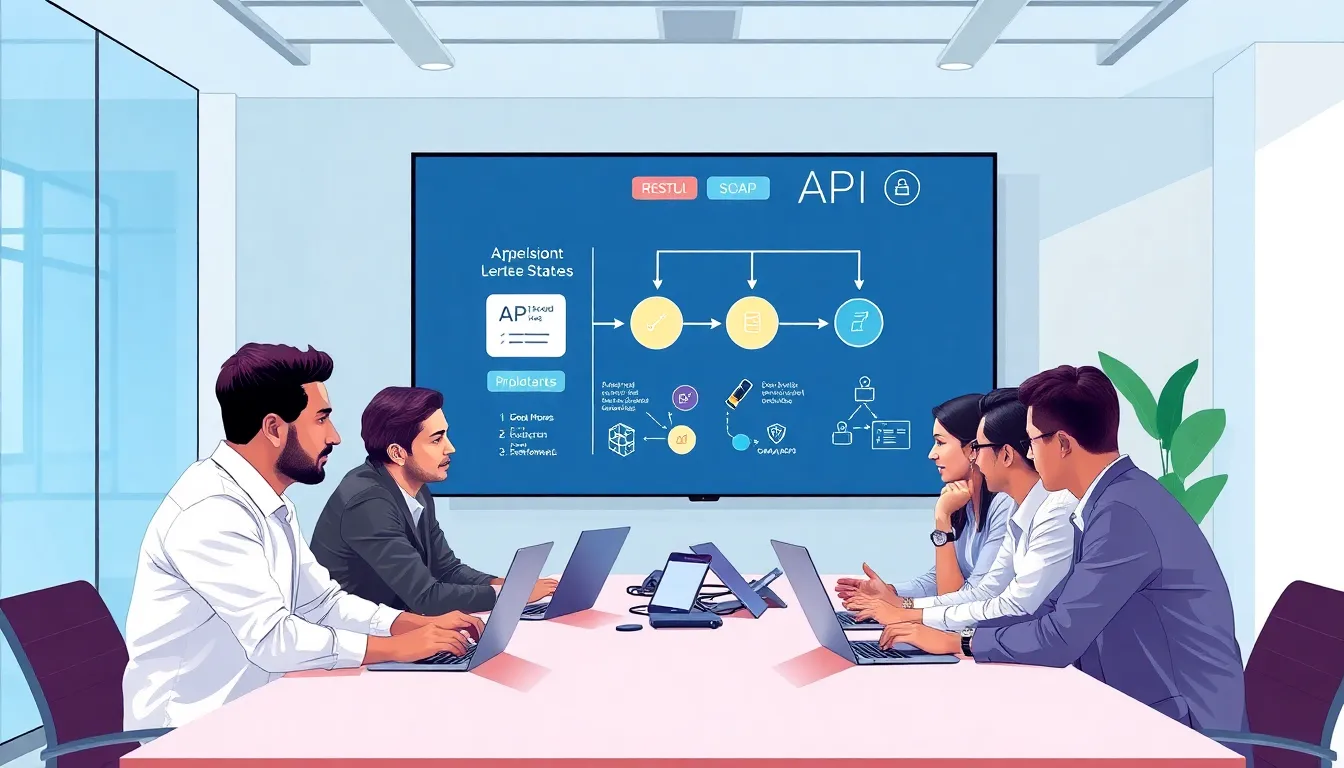In today’s tech-savvy world, businesses are scrambling to keep up with the latest trends. Enter the API solution—a magical bridge connecting different software applications like a tech-savvy matchmaker. Imagine trying to get two people to dance without introducing them first; that’s your software without an API.
Table of Contents
ToggleUnderstanding API Solutions
API solutions facilitate communication between different software applications, acting as intermediaries. These solutions streamline interactions, ensuring data flows seamlessly across platforms.
What Is an API Solution?
An API solution consists of a set of protocols and tools enabling software applications to communicate. It defines methods for requesting and exchanging data in a standardized way. By using APIs, developers create integrations that enhance functionality and user experience. Examples include RESTful APIs, which interact using HTTP requests, and SOAP APIs, utilizing XML messaging. Each type serves different use cases, offering varied levels of security and complexity.
Importance of API Solutions in Modern Software
API solutions play a crucial role in today’s software ecosystem, promoting interoperability and innovation. They allow different applications to work together, enhancing efficiency. Companies leverage APIs to integrate external services easily, streamlining operations and reducing development time. Data sharing through APIs also supports real-time analytics, driving informed decision-making. Organizations that adopt these solutions often experience increased flexibility and adaptability in a fast-paced digital landscape. Moreover, APIs foster a collaborative atmosphere among developers, enhancing creativity and problem-solving.
Types of API Solutions

API solutions come in various types, each tailored for specific use cases and communication needs in the software environment. Understanding these types helps organizations choose the right one for their projects.
RESTful APIs
RESTful APIs utilize HTTP requests to perform operations on resources identified by URLs. They offer simplicity and scalability, making them popular among developers. This type supports multiple data formats, with JSON and XML as common examples. RESTful APIs enable stateless interactions, allowing clients to request resources without retaining previous session data. Organizations prefer RESTful APIs due to their ease of use and performance efficiency, especially in web applications and services.
SOAP APIs
SOAP APIs adhere to strict protocols for message formats, utilizing XML for data exchange. Security features like WS-Security enhance these APIs, providing reliable transaction capabilities. In enterprise solutions, SOAP APIs excel due to their robustness and built-in error handling. They operate over various protocols such as HTTP, SMTP, and more. Businesses often implement SOAP APIs when data integrity and formal contracts between services are paramount, especially in financial and healthcare sectors.
GraphQL APIs
GraphQL APIs provide a more flexible approach to data retrieval with a single endpoint. Clients can request only the data they need, resulting in reduced bandwidth usage. This type of API supports complex queries, allowing developers to aggregate multiple resources with one request. Organizations favor GraphQL for its efficiency in fetching large datasets, particularly in mobile applications where performance is crucial. Flexibility and speed position GraphQL as a modern solution for dynamic applications that demand rapid data access.
Implementing an API Solution
Implementing an API solution involves a strategic approach that ensures successful integration and operation within a software ecosystem. The process of API development incorporates several key steps.
Steps to Develop an API Solution
- Define Requirements: Clearly outline the goals and functionalities of the API to meet user needs.
- Design the API: Establish endpoints, data formats, and authentication methods, ensuring clarity in communication.
- Develop the API: Utilize appropriate programming languages and frameworks to build the API, emphasizing efficiency and scalability.
- Test the API: Conduct thorough testing for functionality, performance, and security before deployment.
- Document the API: Provide comprehensive documentation to facilitate ease of use and integration for developers and users.
Best Practices for API Development
- Versioning: Implement version control to maintain backward compatibility and support updates without breaking existing functionality.
- Security Measures: Employ authentication and encryption to protect data and ensure secure communication between applications.
- Error Handling: Design clear error messages to help users troubleshoot issues effectively.
- Rate Limiting: Set usage limits to prevent abuse and maintain optimal performance.
- Consistent Naming Conventions: Use intuitive naming for endpoints and parameters to enhance readability and usability for developers.
Challenges in API Solutions
API solutions face various challenges that can hinder effectiveness and efficiency. Addressing these issues is essential for seamless integration in software environments.
Common Issues Faced
Developers encounter several common issues when working with APIs. Compatibility problems arise when APIs don’t integrate well with existing systems. Additionally, insufficient documentation can create confusion, making it difficult for developers to understand how to use the API effectively. Rate limiting issues may restrict the number of API calls, impacting performance during high traffic. Security vulnerabilities also pose significant risks, potentially exposing sensitive data to unauthorized access. Lastly, versioning conflicts can create discrepancies between old and new API versions, complicating the development process.
Solutions to Overcome API Challenges
Organizations can implement several solutions to address API-related challenges. Prioritizing comprehensive documentation helps ensure that developers fully understand the API’s functionality and usage. Adopting standard authentication protocols enhances security, protecting data as it flows between applications. Implementing caching can minimize the impact of rate limits and improve response times. Regularly updating APIs and establishing clear versioning practices ensures compatibility with various applications. Hosting user training sessions fosters better understanding among developers, encouraging seamless integration and utilization of API solutions.
API solutions are essential in today’s interconnected tech landscape. They enable software applications to communicate efficiently and effectively. By embracing various types of APIs like RESTful, SOAP, and GraphQL, organizations can tailor their integration strategies to meet specific needs.
Successful implementation hinges on a well-defined approach and adherence to best practices. By addressing common challenges such as compatibility and security, companies can maximize the benefits of API solutions. Ultimately, adopting these technologies fosters a collaborative environment that drives innovation and enhances overall productivity.





